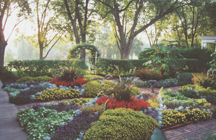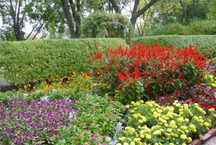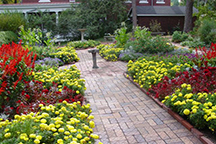MCC's Arboretum
MCC's Arboretum, a Nebraska Statewide Arboretum site, is comprised of six venues located throughout the 70-acre campus. Among them is the General Crook House with its original Victorian-era garden.
General Crook House Victorian Heirloom Garden

Photo by Janice Rutledge
(click for larger image)
The Crook House Victorian Heirloom Garden is the only garden of its kind in this region. It blooms among century-old trees at an authentically restored home built in 1879 for a frontier general. The garden features more than 110 varieties of flowers, some trees and shrubs were carried here on wagon trains and were available by catalog in the 1880s, or were native to Nebraska. The garden overlooks the majestic parade ground and historic buildings of Fort Omaha, and at the rear, along the back drive, are natural wild flowers and prairie grasses.
Every home during this Victorian period of the late 1800s, however modest, included some form of garden fenced or bordered by shrubs to define an outside living space. Gardens provided a welcome escape from summer's heat. The Crook House Garden is edged with Privet, Alpine Currant, Rose trellis and hedges, and the Bridal Wreath Spirea.

Photo by Rita Jerins
(click for larger image)
A unique feature is that it was designed to resemble a parlor rug. Carpet beds (the four center areas) are accented with the patterns and bright colors of an Oriental carpet.
Four other features in the Crook House Victorian Heirloom Garden are original to the garden: the limestone steps and the rock steps, the birdbath fountain and the Eastern Cedar tree near the grape arbor.

Photo by Janice Rutledge
(click for larger image)
This garden is both formal and prairie in its design. Perennial gardens, which border the house, were favored by homeowners of the late 1800s since seeds were scarce, expensive and had to be ordered. Cuttings often were traded or brought from the East to grace the barren yards of a new homesteader.
Of special interest are:
- Fern Leaf Peony or Pioneer Peony: a double, deep red flower in the spring and delicate fern-like foliage until late summer. Rarely found in Omaha (at your right, southeast corner of the house as you enter the full garden).
- Rosa rugosa hedge: a pink flower resembling a single petaled wild rose followed by colorful red hips, separates the formal garden from the fruit, vegetable, herb and cutting gardens (elevated west section), just as the kitchen and servant's quarters are separated from the main part of the house.
- Herb garden: an essential part of every kitchen garden. A typical design was a lover's knot, having no beginning or ending. Oyster shell was used to maintain the pattern, and plants frequently were shorn to show the intricate design.
- Practical fruits: at most homes for jellies, jam, pies and canning of cherry, crab apple, boysenberry, gooseberries and small fruit bushes (near the arbor planted with grapes).
- Cutting beds: no wider than four feet for easy cutting from both sides (near the south porch).
- Fragrant flowers: helped during an age that lacked air conditioning and deodorants. A favorite was the wide-leaf Grandiflora Hosta (northwest side); foliage of the Tansy (Tanacetum vulgare) helped repel ants and other insects.
- Award-winning Sass Iris: historically significant and collected worldwide (south side of the garage). Several varieties were developed by brothers Hans P. and Jacob Sass, who emigrated to Douglas County from Alt Duvestedt, Germany. Jacob's son Henry also won several awards for the "historic Sass Iris."
The Victorian Era was dominated by industrialization and a rising interest in science, and it was during this time that most natural history museums were founded. Both Old World and Midwestern gardeners wanted examples of an exotic bird or plant to show that they, too, were cultured and "modern." As a result, such strange-sounding names as False Dragonhead, Bugbane and Dropwort were featured in the 1888 Burpee's Catalogue. Sultana (Impatiens), available only in red, was a new exotic flower from South Africa. Also new and rare was the romantic Love-Lies-Bleeding (Amaranthus caudatus), whose long drooping shoots are covered with deep red blossoms resembling drops of blood.
The Burpee's Catalogue offered more than seeds. Upon request, readers could receive the Burpee's Manual of Thoroughbred Stock, which listed choice young pigs for "$20.00 to $25.00 per pair, with larger stock at proportionate prices," as well as Scotch Collie dogs, pigs, chickens, sheep and ducks!
The Heirloom Plants
(Includes annuals, perennials, biennials, flowering bulbs, and vines)
Flowers bloom in their own season, and some may not be visible today if you're visiting the garden today. Return during another season! Members of the Crook House Garden Advisory Council and the Garden Society will point out specific locations during Crook House Garden Walks.
General Crook House
The General Crook House Museum, an Italianate style home, is authentically restored and furnished in the Victorian style of that era. It is named for its first occupant, Gen. George Crook, Commander of the Department of the Platte, which was headquartered at Fort Omaha. He was a Civil War hero and called "the nation's finest Indian fighter" by Gen. William Sherman. Crook spoke on behalf of Ponca Chief Standing Bear during the 1879 landmark trial that, for the first time, recognized the Indian as a person with rights within the eyes of the law.
The Crook House is listed on the National Register of Historic Places and is operated by the Douglas County Historical Society. The Historical Society also operates the Library/Archives Research Center, which is located north of the Crook House. As one of the Metropolitan Community College Arboretum venues, it is part of the Nebraska Statewide Arboretum.
Crook House Garden Walks are held annually the last weekends in June and August, and include a tour of the House, the Garden, Museum Shop and changing exhibits. The Museum is available for private functions such as weddings, receptions, teas, dining business meetings or "Try on History" costume birthday parties. Conducted tours and group rates are available.
Open Monday-Friday, 10 a.m. to 4 p.m., Saturday and Sunday 1 p.m. to 4 p.m.
Admission/Donation:
- $5 Adults ($6 holidays and special events)
- $3 ages 6 to 12
- $4 Students (with ID)
Arboretum Venues
